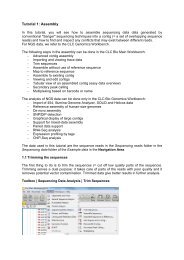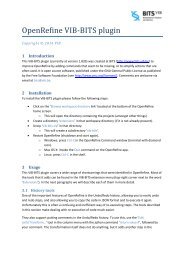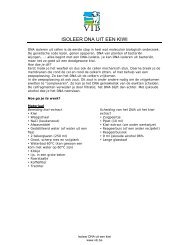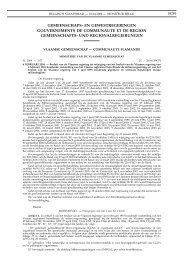Biosafety in the laboratory - VIB
Biosafety in the laboratory - VIB
Biosafety in the laboratory - VIB
You also want an ePaper? Increase the reach of your titles
YUMPU automatically turns print PDFs into web optimized ePapers that Google loves.
Conta<strong>in</strong>ment at <strong>the</strong> source<br />
As is <strong>the</strong> case for any o<strong>the</strong>r activity that may present a risk, one should always try to tackle<br />
<strong>the</strong> risk at its source. Among o<strong>the</strong>r th<strong>in</strong>gs, this means that one should always opt for organisms,<br />
host organisms or vectors present<strong>in</strong>g less risk, but provid<strong>in</strong>g <strong>the</strong> same results as<br />
<strong>the</strong>ir alternatives that do pose a threat. In order to achieve conta<strong>in</strong>ment at <strong>the</strong> source,<br />
researchers should, if possible:<br />
•use a biologically conta<strong>in</strong>ed or attenuated <strong>laboratory</strong> stra<strong>in</strong> <strong>in</strong>stead of a<br />
wild-type stra<strong>in</strong>,<br />
•use a non-mobilisable vector <strong>in</strong>stead of a self-transmissible one,<br />
•use a replication-defective virus or viral vector <strong>in</strong>stead of a<br />
replication-competent one.<br />
Physical conta<strong>in</strong>ment<br />
Physical conta<strong>in</strong>ment comprises all physical measures that are taken to protect organisms<br />
from <strong>the</strong> surround<strong>in</strong>g environment and vice versa. This starts with <strong>the</strong> conta<strong>in</strong>er hold<strong>in</strong>g<br />
<strong>the</strong> organism (for <strong>in</strong>stance, a tube), but it also comprises <strong>the</strong> structure, floor, walls, ceil<strong>in</strong>g,<br />
doors and w<strong>in</strong>dows of <strong>the</strong> <strong>laboratory</strong>, as well as benches that are suitable for work<strong>in</strong>g with<br />
pathogenic organisms or genetically modified micro-organisms. To allow <strong>the</strong> handl<strong>in</strong>g of<br />
micro-organisms, <strong>the</strong> benches should have a smooth surface and be readily decontam<strong>in</strong>able.<br />
A s<strong>in</strong>k should be present to allow <strong>laboratory</strong> staff to wash <strong>the</strong>ir hands after an experiment.<br />
When a higher conta<strong>in</strong>ment level is required (2,3 or 4), a number of additional physical<br />
conta<strong>in</strong>ment measures will be taken (depend<strong>in</strong>g on <strong>the</strong> risk <strong>the</strong> activity represents),<br />
such as:<br />
• class I, II or III safety cab<strong>in</strong>ets<br />
• negative air pressure <strong>in</strong> <strong>the</strong> <strong>laboratory</strong><br />
• an air-lock<br />
•a shower<br />
• HEPA filtration of <strong>the</strong> exhaust air<br />
•special cups and o<strong>the</strong>r equipment to prevent <strong>the</strong> spread of aerosols<br />
• gas-tightness of <strong>the</strong> <strong>laboratory</strong> to permit gas decontam<strong>in</strong>ation<br />
• etc.<br />
An overview of all legally required physical conta<strong>in</strong>ment measures is listed <strong>in</strong> annex 1.<br />
Safety cab<strong>in</strong>ets<br />
A safety cab<strong>in</strong>et is an important type of physical conta<strong>in</strong>ment. In fact, a safety cab<strong>in</strong>et<br />
creates a safe work<strong>in</strong>g space with<strong>in</strong> <strong>the</strong> <strong>laboratory</strong>. Safety cab<strong>in</strong>ets are designed to protect<br />
<strong>the</strong> worker <strong>in</strong> <strong>the</strong> first place and <strong>the</strong> environment <strong>in</strong> <strong>the</strong> second place. A dist<strong>in</strong>ction is<br />
made between three types of safety cab<strong>in</strong>ets: class I, II and III. A class I cab<strong>in</strong>et is a fume<br />
hood <strong>in</strong> which exhaust air passes through a HEPA filter. This type of cab<strong>in</strong>et provides worker<br />
protection, but no experiment protection.<br />
Conta<strong>in</strong>ment: a comb<strong>in</strong>ation of <strong>in</strong>frastructure and work<strong>in</strong>g practices 21
















